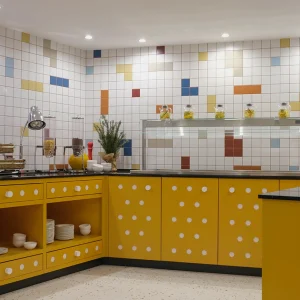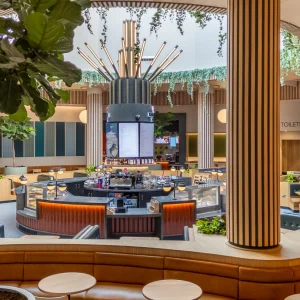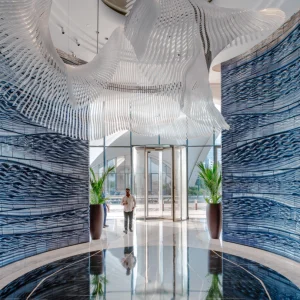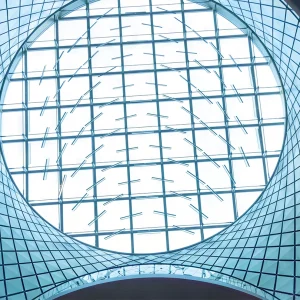
Words: Alastair Donald
China may be engaged in the most ambitious urbanisation in history, a transformation that each year sees millions of people swap a dead-end existence in rural backwaters for the possibilities thrown up by life within a metropolitan network. Yet the imagination of many Western observers seems to be fired by a bleaker vision of the future. As Danish artist Jesper Just explains of his new film Intercourses, set in the new town of Tianducheng in the Yangtze River Delta: ‘I like the idea of a ruin in progress.’
Tianducheng has gained a reputation as both a ‘theme town’ and a ‘ghost city’. This satellite to the city of Hangzhou is China’s version of Paris: a replica Eiffel Tower graces the central ‘Champs Elysees Square’ which is in turn located adjacent to a Versailles-style parterre garden; the surrounding townhouses simulate those in the French capital’s Boulevard Haussmann. However, like a number of new towns in China, Tianducheng remains largely unoccupied, its houses empty, streets deserted, and its architectural reproductions surrounded by the detritus of unfinished construction work. By contrast with, say, Detroit, where ruinous districts of city have been abandoned, China’s desolate new places have never been inhabited.

Parterre gardens and a copy of the fountain at the Palace of Versaille decorate Hangzhou’s ‘Oriental Paris’ Photo credit: Bianca Bosker
Intercourses interweaves the stories of three inhabitants of Tianducheng. But it’s the otherworldly Tianducheng itself that is the main protagonist in the grainy black and white footage of this multichannel film installation. Commissioned for the Venice Art Biennale by the Danish Pavilion, the five screens transmit an architectural fantasia that bridges East and West, true-to-life and ersatz. The pavilion was even wrapped in an exterior skin of cheap, aerated concrete blocks to emphasise contrasting states of construction and decay.
Just joins a growing band of Western commentators in print and film who interpret China’s urban future through meditating on its architectural mimicry and deserted cities. But what’s behind the trend for duplicating western structures and historic places, why do some remain unoccupied and how have they come to provoke such fascination in the West?

‘Real’ China, in the form of skyscrapers, mark the edge of the the old-world copycat town of Tianducheng Photo credit: Jesper Just
Original copies
Lustrous modern structures such as OMA’s CCTV Tower and Zaha Hadid’s Galaxy Soho have gained prominence as symbols of China’s urban transformation. But away from the transformed CBDs, in the new suburbs and satellite towns of China’s burgeoning cities, a 20-year construction boom has given birth to landscapes that seem both familiar and strange. These are China’s ‘theme towns’, the products of what has been called ‘imposturbanism’, or the phenomenon of replicating historic cities elsewhere in the world.
These identifiable Western prototypes have been transplanted into the Middle Kingdom not as isolated occurrences but extensively and at scale. Metropolitan Hangzhou, for example, incorporates not only the copycat Paris that is Tianducheng, but neighbourhoods such as the Mediterranean-inspired ‘Goya’ neighbourhood and duplications of individual structures such as the Washington Monument and Mount Rushmore. It is even possible to ride a gondola through Venice Water Town, complete with its copies of St Mark’s Campanile and the Doge’s Palace.

A classically styled staircase is left unfinished and going nowhere, as captured in Jesper Just’s film Photo credit: Jesper Just
Elsewhere, Thames Town outside Shanghai is but one of the satellite settlements created under the ‘One City, Nine Towns’ initiative. The others replicate townscapes from Scandinavia, Spain, Canada, the Netherlands, Italy and Germany. Meanwhile Chengdu has its replica Dorchester, Shenyang its New Amsterdam. According to one estimate, in 2008 China’s largest real estate developer, China Venke, built approximately two thirds of its residential properties in a European theme.
On one level architectural mimicry is a pragmatic response to the need for economic and social stability in the face of the disruptive effects of China’s modernisation. As the urban populace rapidly expands, adapting Western prototypes and utilising imported architectural and technical expertise helps offset the lack of domestic accumulated experience and creates an expedient solution to the need for speed.

Venice Water Town has its own canals, Venetian-style architecture and gondola rides Photo credit: Bianca Bosker
Given real estate takes one fifth of all Chinese investment and fuels the domestic demand judged vital to maintaining growth, saving time and fees in design supports the quick returns on investment necessary to maintain an expansionary dynamic. With the current five-year plan targeting 36 million new homes before 2015, wholesale importation of styles assists the swift delivery of vast new masterplans while antiquated European skins ‘brand’ otherwise interchangeable gated neighbourhoods.
Despite the seeming fidelity to Western themes, replica towns are what journalist Bianca Bosker has termed Original Copies. In her impressive study of China’s ‘duplitecture’ (often rather gratingly termed ‘simulacrascapes’), Bosker points out that themed developments are heavily modified to Chinese preferences. That judged iconic or attractive from the European order is selectively incorporated while the rest is ignored or revamped.

Venice Water Town China, with its own St Mark’s Campanile and Doge’s Palace Photo credit: Bianca Bosker
In the Tianducheng version of Paris, for example, icons from across France including Arena of Nîmes are assimilated. But layouts and buildings are often customised or rescaled to local requirements: neighbourhoods are gated to assuage anxieties over security and orientation adapted according to feng shui; courtyard forms are re-worked in line with modern notions of privacy while historic styles are adapted to modern and alien typologies. Consequently, although ‘copycat cities’ are often derided as fake or kitsch, Bosker argues they are better understood as the construction through space of a distinctly Chinese story, one intended to symbolise China’s own modernisation.
Just 40 years ago, the Maoist diktat of ‘Functional, economical; delightful if conditions permit’ reflected the brutal reality of Maoist mis-industrialisation that reduced the urban prospects for most Chinese families to a grim apartment on a bleak estate. With recent national architectural idioms devoid of space for the expression of wealth or aspiration, theme towns mimicking the historic architecture of Western accomplishment can be understood as symbolising China’s own climb to modernity; they broadcast the sophistication and lifestyle choices of the upwardly mobile and their attainment of modern space standards and comforts common to the developed West.

Security guards patrolling Thames Town – a mix of Gothic, Tudor and half-timbered buildings Photo credit: Bianca Bosker
In this sense, complaints that replica towns lack authenticity and are divorced from Chinese cultural and architectural traditions actually miss the point: duplicating the architecture from key moments in Western history can appeal precisely as an expression of belief that China can break with its own past. Of course in the fatalistic West, the idea that individuals and society can make progress through reinventing themselves and actively changing their circumstances is distinctly unfashionable. Indeed the desire to cling to the past over ‘imagineering’ the future means that in the West, China is regularly criticised when the likes of Beijing’s fabled (but dilapidated and often unsanitary) hutongs and siheyuan are replaced by modern development.
New places dubbed Galaxy Dante or Garden of Monet may seem fanciful of course, more so given their developer sponsored festivals and cultural initiatives offering residents the opportunity to sample Western customs, food and leisure activities. If cosmopolitan, comfortable lifestyles are the aim, then in reality design and construction standards frequently remain poor.

‘Hilltop Castle’ is a popular wedding venue, perched above ‘Little French Town’ Photo credit: Bianca Bosker
It is, however, worth questioning the western critics’ point of objection. Urban theorist Mike Davis has derided replica suburbs as Blade Runner-esque ‘off worlds’ for the wealthy. Yet in his apocalyptic view of the developing world’s modernisation, the picture he paints of social fragmentation and ecological destruction seems more a complaint directed at those who have acquired Western standards of living — the standards that most of us feel happy to enjoy and uphold — as much as agitating for those left behind. No doubt to the cheers of sustainability advocates everywhere, American commentator Thomas Friedman puts it more bluntly: China must lower its ambitions, he says, because if President Xi Jinping’s dream for the nation’s emerging middle class is ‘just like the American Dream (a big car, a big house and Big Macs for all) then we need another planet’.
Ghost cities
It is early days for these themed developments, and how they function in the long term remains to be seen. Many seem to have attracted full-time residents. Some, however, remain as yet largely unoccupied — Thames Town outside Shanghai, for example, is infamous for its deserted streets save for the couples who visit to pose for wedding photos in front of the cathedral. Here the replica townscape gives the appearance of an empty stage set, in need of people to animate the spaces and bring them to life.
With some reports suggesting that up to 64 million homes in China remain vacant, ‘ghost cities’ are clearly worthy of investigation. Unfortunately genuine insights are so far largely absent and much Western commentary says less about the reality of China’s urbanisation and rather more about Western anxieties about the future. In this respect the film Intercourses is rather typical. Deploying the tired device of the dérive through urban wastelands, utilising screens strategically placed to choreograph a fractured viewing experience, and an ethereal whistling wind to soundtrack an empty city, filmmaker Just is keen to stress emotional states and geographic displacement. Yet as emphasised by the accompanying global poster campaign stressing the ‘liminal space between copy and original’ that engenders ‘locative disorientation’, this is a film rooted in the disoriented world of Western post-modernism.

Other than newlyweds who come to have souvenir photographs taken at the cathedral, Thames Town is deserted Photo credit: Bianca Bosker
Even so it is worth asking whether a recent CBS 60 Minutes programme had a valid point when arguing that China ‘is simply building too much too quickly’. To the extent new Chinese cities do remain unoccupied, it is rarely for one single reason, but rather a result of varied factors ranging from poor locations and infrastructure, to poor design and construction, to the high costs that result from a speculative housing bubble — each of which China clearly needs to address. As some reports highlight, however, some cities are simply in the process of filling up. And with 300 million more urban migrants expected in the next 15 years, they will continue do so.
Today in the West when we embrace restraint and seem unwilling to countenance taking risks, the ambition to master plan new cities on a predicative model is viewed as unrealistic, and indeed undesirable. It is not that some cities remain as yet unoccupied creates the deep disdain invariably attached to the phrase ‘build and they will come’. Rather it is indicative of our own fatalistic, risk-averse outlook which views attempts at rapid and wide-ranging modernisation as an act of hubris that is destined to fail. In his view of Tianducheng as ‘a ruin in progress’, Just merely echoes a widespread view of modernity as representing a loss of control over the future.





